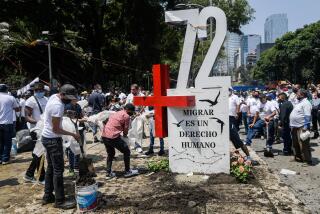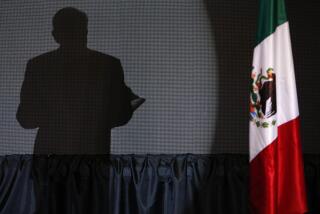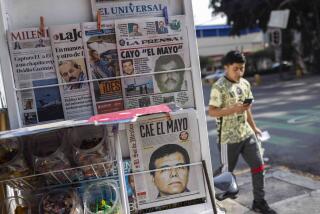Mexico Launches Probe Into Slaying of Bandit at Border : San Diego Police Question Results of New Autopsy
Mexican officials Thursday began their own investigations into the fatal shooting of a Mexican border bandit by San Diego police, while police officials here began to question the results of an autopsy performed in Tijuana that says the man died from a bullet fired at close range.
Tijuana coroner Gustavo Salazar said that officials from the Mexican Interior Ministry in Mexico City questioned him about the autopsy Salazar performed earlier this week on the exhumed body of Julio Arroyo Zaragoza, 33.
“They asked me for information and other data about the autopsy and about my conclusion that the man was shot from up close rather than from 30 feet away, as the San Diego police have said. They also requested copies of my report and other findings from the state attorney’s office so they can investigate the matter,” Salazar said.
Efforts to reach Interior Ministry officials for comment were unsuccessful.
A spokesman for state prosecutor Jose Hernandez Silerio said that the state attorney’s office in Tijuana is also conducting an investigation of the shooting, spurred by the results of the Tijuana autopsy.
And in San Diego, a spokesman for the Mexican Consulate said that his office has requested reports of the Tijuana autopsy and the state attorney’s investigation when it is completed. The spokesman, who did not wish to be identified, said the office will study the reports and may ask Dist. Atty. Ed Miller to investigate the shooting.
“I don’t think this is the kind of case where we would file a protest with Washington. But if we feel that a Mexican citizen died from an unlawful act perpetrated by a U.S. law-enforcement official, we will ask for an investigation by the local authorities,” said the spokesman.
Meanwhile, San Diego Police Chief William Kolender and another police spokesman continued to stand behind the police investigation and questioned the new autopsy performed on Arroyo’s body. On Tuesday, Salazar reported that he had found traces of gunpowder underneath the skin around the bullet wound that killed Arroyo. Such traces of gunpowder indicate a contact wound, a wound suffered when the gun barrel is placed on the skin or very near to it.
Salazar’s findings were corroborated Wednesday in laboratory tests performed in San Diego and analyzed by Dr. Hormez Guard, a pathologist hired by attorney Jose Tafolla. Tafolla is representing Arroyo’s brother, Jaime Arroyo Zaragoza, 23, who was charged with robbery and attempted murder in the May 4 shooting just north of the border.
“Where did the gunpowder come from, if it is gunpowder? My understanding is that they dug up the body, performed the autopsy and buried it again. How did the gunpowder get there?” Kolender asked.
When asked if he was suggesting that Salazar, Tafolla and Guard, who were present at the autopsy, tampered with evidence, Kolender responded: “If we are presented with that evidence, we will look at it.”
When told about Kolender’s comment, an angry Salazar said, “It is apparent that he doesn’t know the first thing about forensics.”
“What is he suggesting--that I pulled back the victim’s skin and rubbed in the gunpowder? Is he saying that I burned the powder before I did that or is he saying that I broke open a cartridge and rubbed in the unburnt powder? That’s a ludicrous thing for him to say. He should take a closer look at the first (autopsy) report (done by the county coroner’s office). That report is deficient,” Salazar said.
San Diego County Corner David J. Stark admitted Wednesday that Dr. David Katsuyama did not do the necessary tests to check for traces of gunpowder around and in the wound suffered by Arroyo in the middle of the forehead.
Kolender stuck by a police report which says that Arroyo was hit by a 9-millimeter bullet fired by Officer Cesar Solis from a distance of about 30 feet.
“We have physical evidence and statements from witnesses that the shot was fired from 30 feet away,” Kolender said.
When it was pointed out that all of the witnesses were either police officers or Border Patrol agents, Kolender replied: “We have a statement from the brother (Jaime Arroyo) too.”
Asked if Jaime Arroyo told police that the shot that killed his brother was fired from 30 feet, Kolender said: “That’s all I’m going to say about it.”
Jaime Arroyo has told Tafolla and family members that police killed his brother after he was wounded and disarmed. San Diego police reported that Julio Arroyo died during an exchange of gunfire with members of the Border Crimes Prevention Unit--composed of San Diego Police and Border Patrol agents.
Agent Fred Stevens, 39, was shot five times by Julio Arroyo, but was saved by an armored vest and is back on duty.
San Diego homicide Lt. Paul Ybarrondo, noting that the exhumation was done without the presence of representatives from the police or the district attorney’s office, questioned the integrity of the autopsy.
“The professional thing to do is that they should have allowed someone to witness the exhumation and the second autopsy,” Ybarrondo said.
Stark expressed the same concern and was quoted as saying that he was surprised that the exhumation and autopsy were done within a matter of days.
Salazar said that Mexican officials anticipated that reaction and went to great lengths to ensure that the request by Tafolla for the exhumation and autopsy was handled through the appropriate bureaucratic channels.
“The request (for the exhumation and autopsy) went through all the proper channels,” Salazar said. “It started at the bottom and worked its way to the top of the state attorney’s office. I was ordered by the state attorney, not Mr. Tafolla, to perform the autopsy. The state attorney ordered another agency to exhume the body, and that was done with the cooperation of the state and local health departments and the fire department.
“It was not a matter of Mr. Tafolla coming in on Sunday telling us he wanted the body dug up, digging up the body on Monday and doing the autopsy on Tuesday. No, we anticipated this reaction from the Americans.”
Tafolla said it took two weeks from the day that he requested the exhumation to the day the autopsy was performed.
Miller said his office is awaiting the reports of the Tijuana autopsy and laboratory tests done in San Diego before deciding whether to investigate the shooting.
“I haven’t been contacted by anybody. Usually when someone has something that might affect a case he would come into my office with the evidence,” Miller said.
But Miller added that based on Katsuyama’s autopsy report, he saw no evidence that Arroyo was shot at close range.
“Our autopsy report shows no close contact (wound), and we are proceeding with the results of that autopsy,” Miller said.
But Miller agreed with Stark that Katsuyama failed to perform some microscopic tests that would have shown if the the fatal bullet resulted from a contact wound.
“That’s true, he didn’t do the tests. But one could conclude that under the circumstances those tests were not necessary because there was no indication of a contact wound,” Miller said.
Stark said Katsuyama saved tissue samples taken from the bullet’s path through Arroyo’s brain. Stark said those samples would now be studied and that results should be available by next week.
“If we’ve got a tight contact wound we should be seeing some powder particles,” Stark said.
Meanwhile, Tafolla said that Jaime Arroyo has turned down a prosecution offer to drop the attempted murder charge in exchange for a guilty plea to the robbery charges. Prosecutors offered to recommend no more than three years in state prison if he pleaded guilty to the robbery charges.
“Jaime turned it down. He wants to go to trial because he believes he will be acquitted,” Tafolla said.
More to Read
Sign up for Essential California
The most important California stories and recommendations in your inbox every morning.
You may occasionally receive promotional content from the Los Angeles Times.










